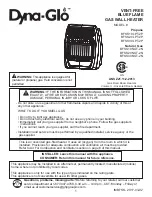
Page 18
Where condensation is unavoidable traps should be included to encourage the condensates to flow freely to a point
from which they may be released, preferably into a gully. The condensate pipe from the flue to the disposal point must
be made from corrosion resistant pipe of not less than the internal diameter of the drain pipe.
If the flue passes through a wall, ceiling, or roof made from combustible material then it has to be sleeved so as to
provide a minimum of a 25mm void between the exterior of the flue and the internal wall of the sleeve. The maximum
permitted temperature of any adjacent combustible material is 65°C.
The position of the flue and its terminal should be such that it does not impair the combustion process. It should
terminate in an exposed position so as to allow the escape and dissipation of flue gases without risk of their re-
entering the property through windows, ventilation ports, etc. The flue should extend to at least 1m above the height
of any object within 3.5m of the terminal.
Flue terminals should be fitted on all flues, the terminal must be of the approved type, and have outlet grilles on all
sides giving a total free area of at least double that of the flue.
CAUTION
It is imperative that the flue should be properly sealed where it passes through the roof, this can best be
achieved by using the approved method of roof flashing plate and cravat.
It should be noted that claims made under warranty and attributed to the ingress of water may not be
considered especially if an approved method of sealing has not been used, or if the design of the flue has not
made provision for possible condensation problems.
Содержание OUH 100
Страница 46: ...Page 46 Notes...
















































